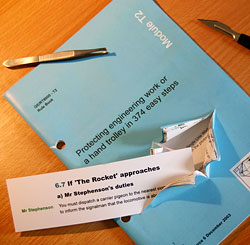Going through the motions
Publishing safety plans has always been a risky business. If they’re adventurous, sceptics pour cold water on them. If they’re contentious, the resistance loads its guns. And if they come to nothing, an indelible benchmark is established against which failure can be measured.
The railway’s Strategic Safety Plan has cleverly neutralised any sense of expectation by accumulating more fluff than a hoover in a pillow factory. Rather than clear, specific objectives, it now comprises a series of ‘trajectories’ supported by existing company initiatives. For example, the loose aspiration of a “reduction in the rate of track worker accidents” is, in part, being driven by “controls which are more sensitive to human factors” and “embedding safety performance into business processes”. Like nouvelle cuisine, this drizzle of gobbledygook infused with a julienne of charts, graphs and glossaries is an unappetising triumph of design over substance.
|
| ...this drizzle of gobbledygook infused with a julienne of charts, graphs and glossaries is an unappetising triumph of design over substance. |
|
In contrast, Network Rail served up no-nonsense pub grub with its 2003-6 Safety and Environment Plan. Taste buds were tickled and lips licked in anticipation. Looking back over its working life, a mixed picture is revealed in terms of track safety successes. ‘Could do better’ might be a reasonable verdict, though it’s worth recognising that this was a period of great corporate upheaval which consumed managerial time by the wagonload.
So what was delivered? Permanent lighting will make life easier at some critical junctions. Fixed TCODs didn’t make the grade. National requirements for PPE are in place, including the garnish of compulsory hardhats. Red zone prohibitions were all revisited, though on-site signposts have yet to be installed. Diplomacy demands that I overlook the aborted fitment of semi-permanent ATWSs (ooops!) and instead celebrate upgrades to the line blockage booking system. The pledge to “radically simplify and rationalise” paperwork was not embraced with enthusiasm.
Three other commitments passed by my soapbox last year - each is worthy of closer scrutiny. Things have moved on and not always for the better.

Efforts to review T12, T2 and T3 and replace them with “a simpler suite of control measures” have, thus far, come to nothing. Never have so many fine words been spoken yet so little achieved. According to its “Roadmap for simpler possessions”, produced by NR in September 2003, we should now be enjoying a whole raft of procedural advantages, making line blockages safer, easier and more efficient. Instead, T3 gets another reshuffle in June whilst the decluttering of T2 - originally set for last December - will not happen before December ’07, if at all.
Loitering in the plan’s 2005 appendix was a pledge to “develop and trial lightweight LOWS” through engagement with manufacturers. Conventional kits offer humongous proportions and logistical nightmares as standard. Not so Park Signalling’s Train Alert Handswitch - a simple, pocket-sized gizmo employing off-the-shelf technology with a mobile phone connection.
Network Rail’s encouraging noises were stifled shortly before Christmas when the prototype was stamped upon from the highest level. A competitor’s device also ran into difficulties. With LOWS failing to set the world on fire, now seems a curious time to look a gift horse squarely in the mouth, particularly when it’s just demolished the barrier of impracticality. Perhaps safety improvement has no attraction unless it breaks the bank and keeps a thicket of researchers occupied.

Steaming deposits in the four-foot do little to enhance a passenger’s experience of the railway. Thankfully the infrastructure owner declared its intention to tackle “effluent accumulation at stations”. For two years, East Coast operator GNE-Urgh has been trialling its own ingenious solution - discharging excess filth from its lavatories onto unsuspecting trackworkers as refurbished Mallard stock flies through the countryside.
Back in August, the company insisted that these emissions resulted from a lack of tank emptying facilities at Heaton depot, one of its six overnight stabling sites. So, with new facilities now operational, are our lineside comrades breathing a sigh of relief? Far from it. When checks were made in December, waste was escaping from one in three Class 91s, with offending trains emanating from Polmadie and Neville Hill, not just Newcastle.
With the fighting spirit of an England footballer, Network Rail has shunted some of its teams onto nights and wheeled out a health expert to reassure staff that E.coli-infested spray is in fact harmless. The HSE medical advisor who previously pronounced that "there is a significant hazard to health associated with exposure to human waste" was clearly deluded. Fact is, whatever its true potential, trackworkers should not be showered in sewage. In every sense, the whole thing stinks.
Plans are one thing, action is something else. Behind those seductive, glossy brochures, there are still battles to be won. These must be fought with vigour and determination. Too many Sentinel card holders are disillusioned by trivia, spin and a belief - generally an errant one - that our superiors are just going through the motions. This creates its own risks. Let’s build on our victories before the regulator rises from its slumber. Whatever happened to HMRI, by the way?
Story added 1st February 2007
|